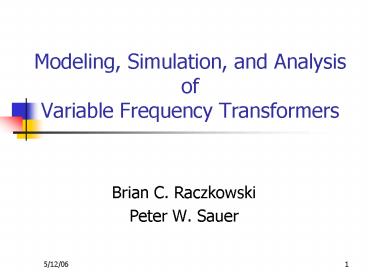Modeling, Simulation, and Analysis of Variable Frequency Transformers
1 / 31
Title:
Modeling, Simulation, and Analysis of Variable Frequency Transformers
Description:
Exchange 100MW to -100MW between power grids of Quebec (Canada) and New York (USA) ... The machine is assumed to be a two-pole three phase machine with an a:1 ... –
Number of Views:1752
Avg rating:3.0/5.0
Title: Modeling, Simulation, and Analysis of Variable Frequency Transformers
1
Modeling, Simulation, and Analysis of Variable
Frequency Transformers
- Brian C. Raczkowski
- Peter W. Sauer
2
Overview
- Power Flow Control
- Langlois Converter Project
- Derivation of Model
- Small Power System Case
- Experimental Case
- Future Work
3
Ways to control power flow
- Prime mover and excitation control of generators
- Open and Close Breakers
- Reactive Power Compensation
4
Ways to control power flow (cont.)
- High Voltage DC (HVDC)
- Rectifies AC to DC then inverts DC to AC
- Economical for long distances
- Harmonics
- Isolation
- Frequency
5
Ways to control power flow (cont.)
- Transformers
- Tap-Changing-Under-Load (TCUL) Transformers
- Ability to change the ratio of transformation
while energized - Requires additional circuitry
- Phase shifting transformer
- Addition of 90 out of phase voltage
- Useful for controlling real power
- Most cases there is a fixed range
6
Drawbacks of These Methods
- Set minimum and maximum constraints
- Fixed change
- Power transfer frequency requirement
- Harmonics
7
Another Kind of Transformer
- Induction machine
- Squirrel cage rotor
- Conducting bars laid in slots and shorting rings
- Wound rotor
- 3F windings with mirror images of windings on
stator
8
Another Kind of Transformer (cont.)
- Doubly-Fed Induction Machine (DFIM)
- Rotor end not shorted
- Wound rotor machine with access to rotor windings
- Slip rings provide connection to rotor
- Typically used to alter torque-speed curve
- Same as Variable Frequency Transformer (VFT)
9
VFT Advantages
- Continuous and no fixed set change points
- Response for stability purposes
- Simple model for power system use
- HVDC alternative
- Can transfer power at different frequencies
- More control of the real power flow
10
VFT Disadvantages
- Limits on maximum power flow capability
- More lossy especially in reactive power losses
- Works at low kV range so it needs step up/down
transformers
11
Langlois Converter Project
- GE investigated a new power transmission
technology (2002) - Variable Frequency Transformer (VFT)
- Controllable, bidirectional transmission device
with ability to transfer power between
asynchronous networks
12
Worlds First VFT
- Hydro-Quebecs Langlois substation
- Exchange 100MW to -100MW between power grids of
Quebec (Canada) and New York (USA) - Closed Loop Control System to increase or
decrease power delivery to maintain stability
13
General VFT
- Core technology is rotary transformer with three
phase windings on both rotor and stator - Continuously variable phase shifting transformer
- Uses 2 transformers, a switched capacitor bank
and a DC motor - Change rotor angle to change the power flow
through the machine - Limits of the phase angle can be set as large as
needed
14
VFT Ideal Use
15
Model Derivation
- The machine is assumed to be a two-pole three
phase machine with an a1 turns ratio
16
Starting Equations
17
Final Equations
18
VFT Model (per phase)
19
Small Power System Case
Glover and Sarma example
20
Small Power System with 3 VFTs
Line 1
Line 2
Line 3
Just by inserting VFTs, the flows have changed
21
Power Flows in Small Power System from -21.9 to
30
22
Experimental System Setup
- GE I689, 7.5 hp, 3F, 6-pole induction machine
- 2.931 turns ratio
23
Experimental System Notes
- Variac used to match odd turns ratio
- Slack Bus was the standard wall outlet
- Load is purely resistive 12.8O
- Source had 10A fuses
- 1 mechanical was 3 electrical
- Verification in PowerWorld Simulator
- Voltage - 1000x
- Power 1e6x
24
Test System Results - No Caps
25
Make Things Better
- System is already inherently lossy
- Add a capacitor bank to cut reactive losses
- 121.5µF to each phase at Bus 3
- Current reduced from 7.03Arms to 2.45Arms
- Needed 61.32V to achieve 7.05Arms
- For comparative purposes Vin20.4Vrms
26
Test System Results with Caps
27
Interesting Cases
- Results verified in Power World Simulator
28
Circulating Real Power
29
VFT Conclusions
- Alternative method to control power flow
- Easy model
- Use in small power system case
- Use in experimental power system case
30
Future Work
- Larger Test Systems
- Higher Voltage
- Torque Analysis
- Multiple Frequencies
- Stability of the System
- Economical Impact
31
Questions
- Questions??































